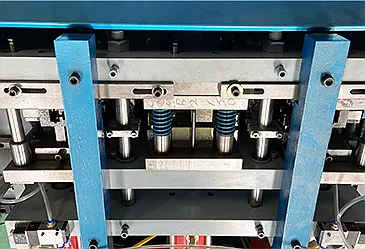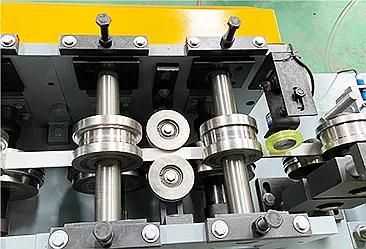Introduction
Ever wondered how long, uniform metal profiles like roofing sheets, C & Z purlins, and highway guardrails are made? The answer lies in the roll forming process—an efficient, high-speed metal shaping method used across multiple industries.
A roll forming machine is designed to progressively shape metal sheets by passing them through a series of precision-engineered rollers. Unlike traditional metal bending methods, roll forming minimizes material waste, reduces labor costs, and enhances production efficiency.
In this guide, we’ll cover:
✅ How a roll forming machine works
✅ Key components of a roll forming system
✅ Step-by-step roll forming process
✅ Types of roll forming machines
✅ Advantages of roll forming over other metal forming methods
Let’s dive into the mechanics behind one of the most efficient metal shaping processes in modern manufacturing!
How Does a Roll Forming Machine Work?
A roll forming machine operates by gradually bending a metal strip into a specific shape through multiple sequential roller stations. Instead of bending the metal all at once (like press braking), roll forming applies incremental bends over several roller stages, ensuring smooth, precise shaping.
Basic Working Principle
1️⃣ Material Feeding – A metal coil is unrolled and fed into the machine.
2️⃣ Gradual Forming – The metal passes through a series of roller stations, each making small incremental bends.
3️⃣ Inline Processing (Optional) – Punching, notching, embossing, or welding can be integrated into the process.
4️⃣ Cutting to Length – The formed profile is cut to the required size.
5️⃣ Final Product Output – The finished part is sent for inspection and packaging.
Pro Tip: The incremental bending process ensures minimal material stress, resulting in high-strength, precision-formed profiles.
Key Components
A high-quality roll forming machine consists of multiple essential components that work together to create complex metal profiles with precision and efficiency.
Major Components & Their Functions
| Component | Function |
|---|---|
| Decoiler | Holds and unwinds the metal coil for feeding into the machine. |
| Feeding Guide System | Aligns and directs the sheet into the rollers. |
| Roller Stations | Multiple rollers progressively shape the metal sheet. |
| Punching/Notching Unit (Optional) | Adds holes, slots, or indentations in the metal before final forming. |
| Cutting System | Cuts the formed profile to the required length. |
| Hydraulic or Servo Motor Drive | Powers the rollers, ensuring smooth material movement. |
| Control System (PLC/CNC) | Automates and monitors the entire roll forming process. |
| Product Output Table | Collects finished parts for inspection and packaging. |
Sunway Machine provides custom-built roll forming machines with advanced automation and precision controls.
Step-by-Step Roll Forming Process
The roll forming process is designed for continuous, high-speed metal shaping, making it ideal for mass production of uniform profiles.
Detailed Roll Forming Process Flow
| Step | Description |
|---|---|
| 1. Material Loading | A metal coil is placed on the decoiler, and the sheet is fed into the machine. |
| 2. Initial Feeding & Alignment | The sheet passes through alignment guides to ensure straight entry. |
| 3. Progressive Roll Forming | The metal sheet moves through multiple roller stations, each applying gradual bends. |
| 4. Inline Punching & Notching (If Required) | Servo-driven punching units create holes, slots, or embossing as needed. |
| 5. Cutting to Length | A hydraulic or flying shear cutting system slices the formed profile at the required length. |
| 6. Final Product Output | The finished part exits onto the output table for quality inspection. |
Pro Tip: Servo-controlled cutting systems ensure precise, burr-free cuts with minimal waste.

Types
Different applications require different types of roll forming machines, each offering unique advantages based on profile complexity, production speed, and automation level.
Comparison
| Machine Type | Best For | Key Features |
|---|---|---|
| Single Profile Roll Forming Machine | Fixed-profile production (e.g., roofing sheets) | Cost-effective, compact design |
| Multi-Profile Roll Forming Machine | Producing multiple profiles with quick-change tooling | Reduces downtime, increases flexibility |
| Adjustable Roll Forming Machine | Customizable width and shape adjustments | Ideal for C & Z purlin production |
| High-Speed Roll Forming Machine | Mass production of uniform profiles | Up to 50 meters per minute |
| Fully Automated Roll Forming Machine | High-precision, CNC-controlled operations | AI-powered defect detection, IoT integration |
Looking for a custom roll forming solution? Sunway Machine offers high-speed, precision roll forming machines for global manufacturers.
Advantages of Roll Forming Over Other Metal Forming Methods
Roll forming is widely preferred over press braking, stamping, and extrusion due to its efficiency, precision, and cost-effectiveness.
Why Choose Roll Forming?
| Advantage | Roll Forming | Press Braking / Stamping |
|---|---|---|
| Production Speed | Continuous process (up to 50m/min) | Slower, batch-based production |
| Material Waste | Minimal waste due to incremental bending | More waste due to trial-and-error adjustments |
| Labor Cost | Low – fully automated process | High – requires manual adjustments |
| Part Consistency | High uniformity for long, repeated profiles | Variations possible in batch production |
| Tooling Cost | Higher initial cost, but lower per-unit cost | Lower initial cost, but higher per-unit cost |
Verdict: Roll forming is the best choice for high-volume, cost-efficient, precision manufacturing.
Common Problems & Solutions
Even with state-of-the-art roll forming machines, operators may encounter challenges such as material distortion, misalignment, and roller wear. Identifying and troubleshooting these issues early ensures smooth production and high-quality output.
Troubleshooting Guide
| Issue | Possible Cause | Solution |
|---|---|---|
| Profile Misalignment | Incorrect roller positioning, loose material feeding | Re-calibrate rollers and adjust material guides |
| Material Slipping in the Rollers | Loose feeder rollers, improper tension settings | Tighten feeder rollers and adjust material tension |
| Surface Scratches or Deformation | Dirty rollers, excessive forming pressure | Clean rollers regularly and adjust forming pressure |
| Inconsistent Cutting Lengths | Faulty cutting system, misaligned blades | Inspect and recalibrate the cutting mechanism |
| Roller Wear Due to High Friction | Lack of lubrication, excessive pressure | Apply proper lubrication and use hardened rollers |
Pro Tip: Regular roller calibration and lubrication can extend machine lifespan by 40% and reduce profile defects significantly.
Future Trends in Roll Forming Technology
The roll forming industry is rapidly evolving with AI, IoT, and automation, improving efficiency, accuracy, and sustainability.
Key Innovations in Roll Forming Machines for 2025
1. AI-Based Defect Detection & Self-Correction
- AI-powered cameras and sensors detect defects in real-time, reducing material waste.
- Ensures consistent profile accuracy without operator intervention.
2. IoT-Enabled Remote Monitoring
- Machines now feature cloud-based tracking, allowing operators to monitor performance remotely.
- Enables real-time diagnostics and predictive maintenance.
3. Servo-Driven Roll Forming Technology
- Enhances speed control, accuracy, and energy efficiency.
- Reduces wear and tear on mechanical components, increasing machine lifespan.
4. Fully Automated Profile Adjustments
- Eliminates manual adjustments when switching between different profiles.
- CNC-controlled automatic profile changes reduce downtime and improve efficiency.
Upgrading to AI-powered roll forming machines can increase production efficiency by up to 50%!
Automation in Roll Forming Machines
Automation is transforming precision metal forming, making roll forming machines smarter, faster, and more cost-efficient.
Key Benefits of Automated Roll Forming Machines
| Feature | Benefit |
|---|---|
| PLC & CNC Control Systems | Ensures precise measurements and minimizes human error |
| AI-Based Real-Time Defect Detection | Identifies issues instantly, reducing material waste |
| IoT & Remote Monitoring | Allows operators to track machine performance from anywhere |
| Automated Profile Changeover | Reduces downtime when switching between profiles |
| Energy-Efficient Servo Motors | Lowers operational costs and improves sustainability |
Fully automated roll forming machines from Sunway Machine improve production efficiency by up to 40%!

Essential Maintenance Tips for Roll Forming Machines
Proper maintenance ensures extended machine lifespan and consistent production quality.
Maintenance Checklist for Roll Forming Machines
| Task | Frequency | Purpose |
|---|---|---|
| Lubricate Rollers & Bearings | Weekly | Prevents wear and tear |
| Check Roller Alignment | Monthly | Ensures accurate profile production |
| Inspect Cutting Mechanism | Quarterly | Prevents defective cuts and misalignment |
| Clean Machine Components | Daily | Removes dust and debris that can affect performance |
| Update Software & Calibration | Semi-Annually | Keeps automation functions optimized |
Pro Tip: Scheduled maintenance can extend machine lifespan by 50% and reduce failures by 70%.
FAQ: Roll Forming Machine Working Principle
1. How does a roll forming machine work?
A roll forming machine gradually shapes metal sheets by passing them through multiple roller stations, each applying incremental bends until the final profile is formed.
2. What industries use roll forming machines?
Industries such as:
✅ Construction (roofing panels, C & Z purlins)
✅ Automotive (structural components, crash-resistant beams)
✅ Solar Energy (solar mounting structures)
✅ Racking & Shelving (warehouse racks, storage systems)
3. What materials can be used in roll forming?
Common materials include:
✅ Galvanized Steel (G30-G90)
✅ Stainless Steel (304/316)
✅ Aluminum (6061/7075)
✅ High-Tensile Steel
4. How much does a roll forming machine cost?
The price ranges from 80,000forbasicmodels∗∗to∗∗80,000 for basic models** to **80,000forbasicmodels∗∗to∗∗1,200,000 for fully automated, AI-driven machines.
5. Where can I buy a high-quality roll forming machine?
For custom-built, high-speed roll forming machines, visit WUXI SUNWAY MACHINERY CO., LTD.
Final Thoughts
Investing in a roll forming machine is essential for industries that require flexibility, efficiency, and high-speed production. Choosing a trusted manufacturer ensures long-term reliability and profitability.
WUXI SUNWAY MACHINERY CO., LTD is a leading global manufacturer of custom-built roll forming machines, offering advanced technology, expert support, and competitive pricing.
Want a roll forming machine? Contact us today!
